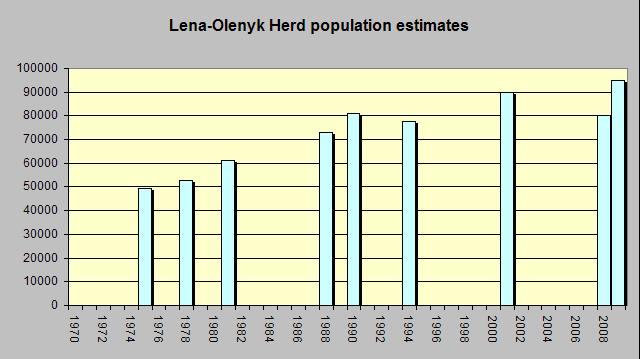Status and Trends
There are three herds recognized in Yakutia; the Lena-Olenyk, the Yana-Indigurka and the Sundrun. In the 17th century, 700 000-900 000 wild reindeer were presumed to populate Yakutia. From 1920 through 1930 their numbers were been drastically reduced due to uncontrolled hunting and the expansion of the domestic reindeer herding industry. The mainland tundra populations started to increase from 1950 through 1960. By 1963-1965 the number in the three herds was 80 000 animals increasing to 230,000 to 240,000 by the late 1980s. This increase was maintained by high reproductive rates, favourable sex ratios and low hunting. The stability of the Lena-Olenyk herd may be explained by reindeer recruitment from the neighboring Taimyr herd. These two herds are known as genetically close and once in the past were a single unit. The other positive reasons for this population to be stable are a relatively light hunting pressure and relatively low proportion of adult females in the harvest.

With the population increase of the mainland populations during the 1970-1980s their seasonal ranges became larger. The distribution range of the Lena-Olenyk herd expanded to 380,000 sq. km. In recent years there have been significant changes in the distribution of the herd. In 1970-1980 a gap occurred in its distribution caused by slow disappearance of the Ust-Lena subpopulation that inhabited the Lena delta river and the adjacent territories. According to aerial censuses in 1963 there were 20,000 reindeer in the Lena Delta (99.5% of the Lena-Olenek herd), in 1975 - 22,200 (62.7%), in 1978 − 35,200 (82.5%), in 1981 - 16,000, in 1982 − 15,000 (34%), in 1988 − 5,000 (6,8%), 1990 − 2,500 (3,1%), 1991 - 600, 1994 − 700. Today the rich summer ranges in the Lena delta are not used by the herd. Large groups often come to the delta edge but do not move further. The main reason lies in loosing their tradition to migrate across the river streams to large islands of the Lena delta after the Ust-Lena subpopulation was lost.

